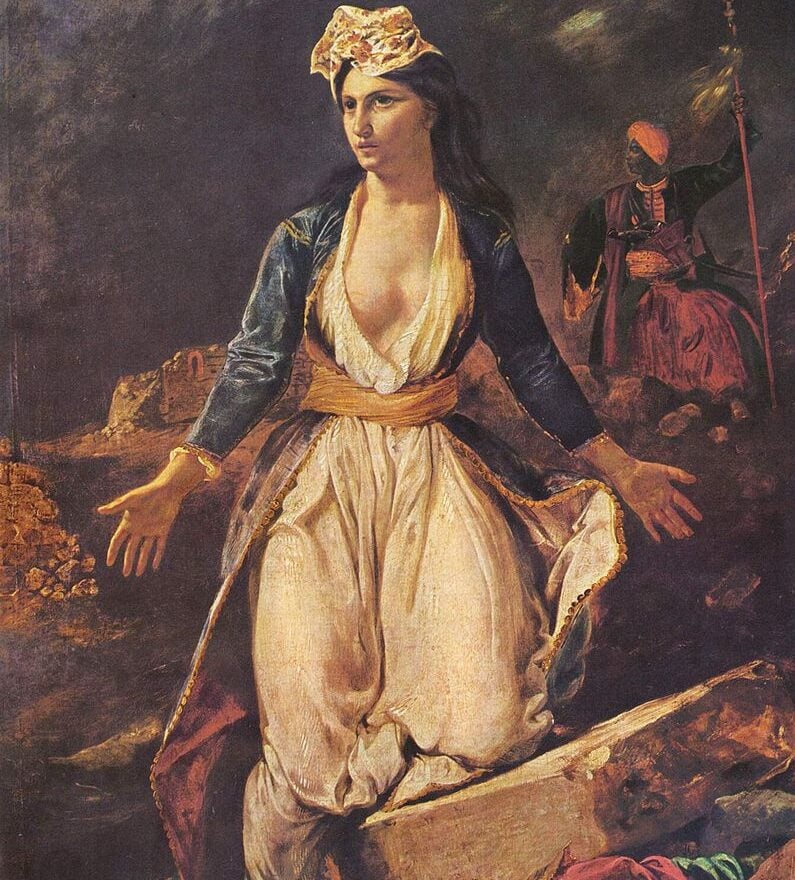

Eugene Delacroix’s emblematic painting, Greece on the Ruins of Missolonghi, will be displayed in Greece as part of celebrations marking 200 years since the heroic Exodus of Missolonghi, one of the most important events of the Greek War of Independence.
The announcement was made on Monday by Greek Deputy Culture Minister Iason Fotilas. The minister said that after coordinated efforts by the ministry, the Musee des Beaux-Arts in Bordeaux, France, where the famous painting is permanently displayed, agreed to Greece’s request for its display at the Xenokrateion Archaeological Museum in Missolonghi in 2026.
The painting, which is rarely moved, was painted by the 19th Century French Romantic painter in 1826. It depicts Greece as one of the brave women of Missolonghi during the city’s long siege by the Turkish army. The attempt of famished Greeks to escape in the night between April 10-11, 1826, ended in tragedy, as the Ottoman army slaughtered almost all of them. The white and blue clothes of the woman who is on her knees pleading for help symbolize the colors of the Greek flag.
The painting was a response to that tragic event and took three months to complete. Delacroix was one of the many European artists who supported the Greek cause.
The presence of the painting at Missolonghi will add an important cultural and symbolic significance to the celebrations, marking 200 years since the heroic exodus, which will be a key cultural moment not just for the city of Missolonghi but also for Greece.
It was on April 15, 1825, three years after a failed attempt to occupy Missolonghi, that the Ottoman armies returned to besiege the city. It had become the seat of the Senate of Western Continental Greece.
The army of Resid Mehmed Pasha, or Kioutachis, as Greeks called him, numbering 20,000 men, began the second siege of the city, later to be joined by another 10,000 men under Ibrahim Pasha, who arrived from the Peloponnese campaign.
The siege of the city can be divided into two periods: the first period from April 15 to December 12, 1825 and the second from December 25, 1825 to April 10, 1826. With civil war raging, the residents of Missolonghi could expect no significant help from the rest of Greece. In spite of the overwhelming enemy forces, they somehow managed to resist for a whole year.
A three-man committee composed of Ioannis Papadiamantopoulos, Dimitrios Themelis, and Georgios Kanavos organized the city’s defense.
The fortress of the city had been restored after the first siege and fortified following the efforts of Alexandros Mavrokordatos, the great philhellene Lord Byron, and engineer Michail Kokkinis.
Within Missolonghi there were 10,000 residents, including 4,000 men, excellent warriors from Epirus and Aitoloakarnania, and another 1,000 men capable of managing weapons.

During the first phase of the siege (April 15 to December 12, 1825) Missolonghi was besieged only by the forces of Kioutachis, and their attacks were easily repelled. The siege from the sea was not effective enough and was repeatedly disrupted by Andreas Miaoulis‘ fleet, which supplied the besieged citizens with munitions and food.
On December 25, 1825, the second phase of the siege began. The two generals of the Ottoman forces were in disagreement, and Ibrahim attacked the city first. On January 16, 1826, Ibrahim admitted his failure in conquering the city and was forced to cooperate with Kioutachis. The two armies stunned the besieged Greeks with a ruthless bombardment.
Missolonghi was without sustenance. The citizens were forced to feed themselves off seaweed, mice, and cats. Under the circumstances, it was impossible for the city to defend itself. On April 6, the board of chieftains decided to make the exodus at midnight on the Saturday of Lazarus through to the dawn of Palm Sunday (April 9 to April 10).
It is estimated that 3,000 Greek men were killed during the Exodus of Missolonghi. The 6,000 women and children of the city were captured as slaves and sold in the slave markets of Constantinople and Alexandria. The Ottoman-Egyptian casualties amounted to 5,000 men.
The Ottoman victory proved to be Pyrrhic, as the barbarity of Ibrahim’s troops and the heroism of the Greeks generated a new wave of philhellenism throughout Europe.
Missolonghi was eventually liberated on May 11, 1829.
